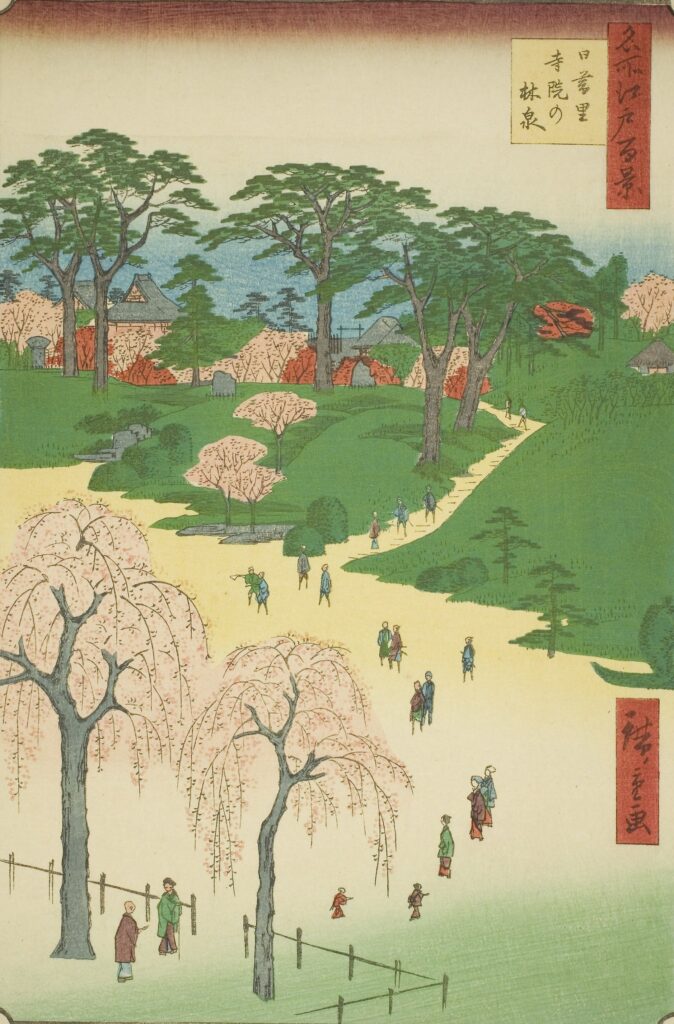
Utagawa Hiroshige – One Hundred Famous Views of Edo – 14 – Spring – Nippori Temple and Forests, Fountains, and Springs 歌川広重-名所江戸百景-14-春-日暮里寺院の林泉 解説
Current Address: Shushoin Temple, Nishi-Nippori 3-chome, Arakawa-ku
Latitude and Longitude: Latitude 35.7287, Longitude 139.7705
Published: February 1857 Age: 61
Comment
<1> Introduction
“Nippori Temple and Forests, Fountains and Springs” depicts the Nippori temple complex, located in the Yanesen area (Yanaka, Nezu, and Sendagi), and the landscape of the forests and springs that spread out behind it.
For the people of Edo, Nippori was not only a temple town, but also a leisure destination where they could enjoy its abundant nature and garden culture.
By combining a temple nestled among the trees with a pond filled with flowing water, Hiroshige skillfully captures the landscape of the “urban oasis” beloved by the people of Edo.
<2> What is Nippori?
The name “Nippori” comes from the fact that there is so much to see that if you spend a whole day here, the sun will set.
For Edo commoners, it was the perfect place to stroll and enjoy the scenery.
During the Edo period, Nippori was home to numerous temples, forming almost a “temple town.”
This area, connecting Negishi and Yanaka, was also a place of worship for samurai and townspeople with parishioners.
Edo’s wealthy and intellectuals had the habit of building gardens (gardens with ponds and waterfalls) in and around Nippori temples to enjoy the changing seasons.
Nippori was home to many temples, including Seiunji Temple, Shushoin Temple, Myoryuuji Temple, Nansenin Temple, Jokoji Temple, and Yofukuji Temple, and each created gardens filled with cherry blossoms and azaleas that were open to the public.
The splendor of the flowers was such that the area was collectively known as “Hanamiji Temple.”
<3> Highlights of the painting
The temple complex, surrounded by forest, exudes an air of tranquility.
It reflects the image of the temple town as a place of spiritual peace, away from the hustle and bustle.
A pond or stream filled with water is depicted in the foreground.
It is a symbol of the gardens and ponds, and demonstrates that worshippers could enjoy the changing scenery throughout the seasons.
The man-made structure of the temple and the natural forest and spring are beautifully integrated into the composition, embodying the Edo people’s taste for gardens and their sense of refinement.
The deep green of the trees and the sparkling water evoke the refreshing atmosphere of summer through early autumn.
The landscape is reminiscent of a summer resort where one can briefly forget the hot Edo summers.
There are two theories about the setting of this painting: Seiunji Temple and Shushoin Temple.
A tree trimmed in the shape of a sailing ship can be seen peeking out from the right frame of the painting.
This tree appears in both “Edo Souvenirs, a Picture Book of Edo” and “Illustrated Guide to Famous Places of Edo,” and it is thought that it was included in the garden of Shusei-in Temple.
The cherry tree in the foreground is a weeping cherry tree.
<4> Nippori Temples for the Common People of Edo
Commoners would visit temples to make pilgrimages and enjoy strolls through the gardens and the beautiful pond scenery.
The area was a vibrant example of Edo lifestyle, combining faith and entertainment.
Many haiku poets, calligraphers, painters, and writers gathered at Nippori’s temples and villas to hold haiku meetings and elegant gatherings.
It was also a place where nature and culture interacted.
This area, where many of the secondary residences of lords and wealthy merchants were located, is famous for its forest and spring gardens.
It was a rare place where commoners could enjoy a “miniature version of a daimyo garden” up close.
<5> The atmosphere of Nippori’s temples remains today
Even today, the area from Yanaka in Taito Ward to Nippori in Arakawa Ward is densely packed with temples, retaining the atmosphere of a “temple town.”
Representative temples include Suwa Shrine, Kyoo-ji Temple, and Enmei-in Temple.
While many of the Edo gardens themselves have been lost, the atmosphere of those days still permeates the slopes and green spaces of the Yanaka, Nezu, and Sendagi areas.
While modern-day Nippori is a temple town, it is also a popular tourist destination, retaining its textile district and retro streetscape.
The coexistence of old and new can be seen as an extension of the “diverse culture-embracing local character” that has continued since the Edo period.
<6> Sightseeing Guide
① Strolling around Teramachi from Nippori Station
Experience the Edo atmosphere while touring the temple complex immediately after leaving the station.
② Yanaka Cemetery and Kan’ei-ji Temple
Experience the temple complex that symbolizes Nippori’s forest and spring culture. It’s also a famous cherry blossom viewing spot.
③ Yanaka Ginza Shopping Street
Enjoy the pleasures of shopping and eating your way around, carrying on the Edo sightseeing culture into the present day.
④ Exploring the Footsteps of Writers and Artists
Dotted with the former residences of modern writers such as Shiki Masaoka and Ogai Mori, this area is perfect for a cultural stroll.

